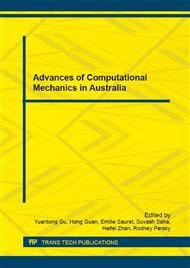[1]
T. Belytschko, Y. Krongauz, D. Organ, M. Fleming and T. Krysl, Meshless methods: an overview and recent developments. Computer methods in applied mechanics and engineering, (1996), 139(1): pp.3-47.
DOI: 10.1016/s0045-7825(96)01078-x
Google Scholar
[2]
V. P. Nguyen, T. Rabczuk, S. Bordas and M. Duflot, Meshless methods: a review and computer implementation aspects. Mathematics and computers in simulation, (2008), 79(3): pp.763-813.
DOI: 10.1016/j.matcom.2008.01.003
Google Scholar
[3]
G. R. Liu, and Y. Gu, A point interpolation method for two-dimensional solids. International Journal for Numerical Methods in Engineering, (2001), 50(4): pp.937-951.
DOI: 10.1002/1097-0207(20010210)50:4<937::aid-nme62>3.0.co;2-x
Google Scholar
[4]
J. Wang, and G. Liu, A point interpolation meshless method based on radial basis functions. International Journal for Numerical Methods in Engineering, (2002), 54(11): pp.1623-1648.
DOI: 10.1002/nme.489
Google Scholar
[5]
G. R. Liu, and Y. Gu, A local radial point interpolation method (LRPIM) for free vibration analyses of 2-D solids. Journal of Sound and vibration, (2001), 246(1): pp.29-46.
DOI: 10.1006/jsvi.2000.3626
Google Scholar
[6]
A. Khoshghalb, and N. Khalili, A stable meshfree method for fully coupled flow-deformation analysis of saturated porous media. Computers and Geotechnics, (2010), 37(6): pp.789-795.
DOI: 10.1016/j.compgeo.2010.06.005
Google Scholar
[7]
A. Khoshghalb, and N. Khalili, A meshfree method for fully coupled analysis of flow and deformation in unsaturated porous media. International Journal for Numerical and Analytical Methods in Geomechanics, (2013), 37(7): pp.716-743.
DOI: 10.1002/nag.1120
Google Scholar
[8]
A. Khoshghalb, and N. Khalili, An alternative approach for quasi-static large deformation analysis of saturated porous media using meshfree method, International Journal for Numerical and Analytical Methods in Geomechanics (2015), 39(9): 913-936.
DOI: 10.1002/nag.2339
Google Scholar
[9]
G. R. Liu, Y. Gu, and K. Dai, Assessment and applications of point interpolation methods for computational mechanics. International Journal for Numerical Methods in Engineering, (2004), 59(10): pp.1373-1397.
DOI: 10.1002/nme.925
Google Scholar
[10]
G. R. Liu, G. Y. Zhang, K. Y. Dai, Y. Y. Wang, Z. H. Zhong, G. Y. Li, and X. Han, A linearly conforming point interpolation method (LC-PIM) for 2D solid mechanics problems. International Journal of Computational Methods, (2005).
DOI: 10.1142/s0219876205000661
Google Scholar
[11]
G. R. Liu, Y. Li, K. Y. Dai, M. T. Luan and W. Xue, A linearly conforming radial point interpolation method for solid mechanics problems. International Journal of Computational Methods, (2006), 3(04): pp.401-428.
DOI: 10.1142/s0219876206001132
Google Scholar
[12]
M.A. Biot, General theory of three dimensional consolidation. Journal of applied physics, (1941), 12(2): pp.155-164.
Google Scholar
[13]
G. R. Liu, and G. Zhang, A normed G space and weakened weak (W2) formulation of a cell-based smoothed point interpolation method. International Journal of Computational Methods, (2009), 6(01): pp.147-179.
DOI: 10.1142/s0219876209001796
Google Scholar
[14]
N. Khalili, M. Khabbaz, and S. Valliappan, An effective stress based numerical model for hydro-mechanical analysis in unsaturated porous media. Computational mechanics, (2000), 26(2): pp.174-184.
DOI: 10.1007/s004660000165
Google Scholar
[15]
A. Khoshghalb, N. Khalili, and A. Selvadurai, A three point time discretization technique for parabolic partial differential equations. International Journal for Numerical and Analytical Methods in Geomechanics, (2011), 35(3): pp.406-418.
DOI: 10.1002/nag.902
Google Scholar


